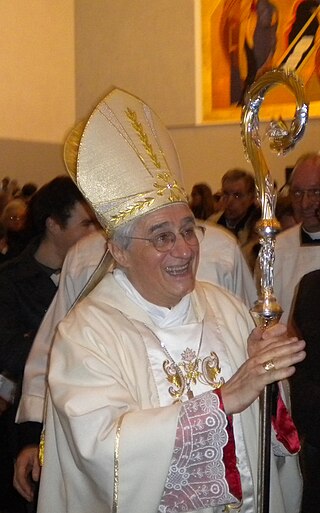Gianni Baget Bozzo was an Italian Catholic priest and politician.

The Diocese of Lugano is a Latin Church ecclesiastical territory or diocese of the Catholic Church in Switzerland covering the canton of Ticino. The diocese immediately subject to the Holy See. In 2004, there were 233,017 baptised persons of 306,846 inhabitants. It has as its principal patron Charles Borromeo, Archbishop of Milan, and as a secondary patron Abundius, Bishop of Como.

The Diocese of Casale Monferrato is a Latin diocese of the Catholic Church in northwest Italy, a suffragan of the Archdiocese of Vercelli which forms part of the ecclesiastical region of Piedmont. The diocese, which adheres to the Roman Rite, was established on 18 April 1474 for political reasons, to transform the Marquisate of Montferrat into an ecclesiastic territory.

The Diocese of Massa Carrara-Pontremoli is a Latin diocese of the Catholic Church situated in north-western Tuscany, in the valley of the Frigido River. The city of Massa is on the south side of the river, 5 km from the Tyrrhenian Sea. The city of Carrara is 6 km north of Massa, on the Carrione River. The diocese is a suffragan of the Archdiocese of Pisa.

The Diocese of Prato is a Latin diocese of the Catholic Church in Tuscany, that has existed as an independent entity since 1954. Its see is Prato Cathedral, some 10 miles northwest of Florence, on the Bisenzio River. The diocese is a suffragan of the Archdiocese of Florence.
This bibliography on Church policies 1939–1945 includes mainly Italian publications relative to Pope Pius XII and Vatican policies during World War II. Two areas are missing and need separate bibliographies at a later date.
Alessandro Borgia was an Italian bishop and archbishop.

Domenico Rossi was a Swiss-Italian architect.
Mario Bernasconi was a Swiss-Italian sculptor.
Eugenio Corecco was a Swiss bishop of the diocese of Lugano. He was a notable 20th century canonist who wrote about the theology of canon law.

Italian irredentism in Switzerland was a political movement that promoted the unification to Italy of the Italian-speaking areas of Switzerland during the Risorgimento.
Camillo Pace was an Italian Protestant pastor known for his work of evangelism and also for having made known, since 1930, the existence in Germany of a Protestant anti-Nazi resistance.

Gianni Ambrosio is the emeritus bishop of the Roman Catholic Diocese of Piacenza-Bobbio.

Streetwise priests are Roman Catholic priests who exercise their spiritual mandate by living in structures in direct contact with the "street", which is their mission land. Historical streetwise priests include Philip Neri (1515–1595) and John Bosco (1815–1888).

Monsignor Vincenzo Regina was an Italian presbyter and historian.

Andrea Tornielli is an Italian Catholic journalist and religious writer who serves as the editorial manager for the Vatican's Dicastery for Communication.

Eugenio Chiesa was an Italian accountant who found a job with a toy factory. He worked his way up through the ranks and, when the opportunity arose, acquired the business and became very rich. By that time he had also entered politics. As a young man he had been greatly influenced by the writings of Mazzini: he remained a committed Risorgimento-republican throughout his life. His long political career was also marked by several high-profile anti-corruption campaigns. Between 1904 and 1926 he served as a member of the Chamber of Deputies. After 1922 he emerged as an uncompromising opponent of Fascism. In June 1924 he was among the first members of parliament openly to accuse Mussolini in connection with the (presumed) murder of Matteotti a couple of weeks earlier. Eugenio Chiesa ended his life in exile.

Roberto Repole is an Italian theologian of the Catholic Church who became archbishop of Turin and bishop of Susa in May 2022. A native of Turin and a priest of that archdiocese since 1992, he taught theology at the university level from 1996 to 2022 and headed the Italian Theological Association from 2011 to 2016.

Sangiorgi report is the name given to a series of notes and reports on the mafia in Sicily by the questore of Palermo Ermanno Sangiorgi and sent to the ministry of the Interior. It is composed of 31 reports, for a total of 485 pages, written between November 1898 and February 1900. The report contains the first complete picture of Cosa Nostra to be made and the first official document that defines the mafia as a criminal organization founded on an oath and primarily focusing on protection racket as its main activity.













